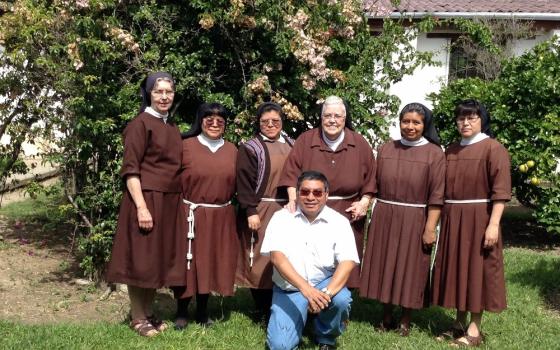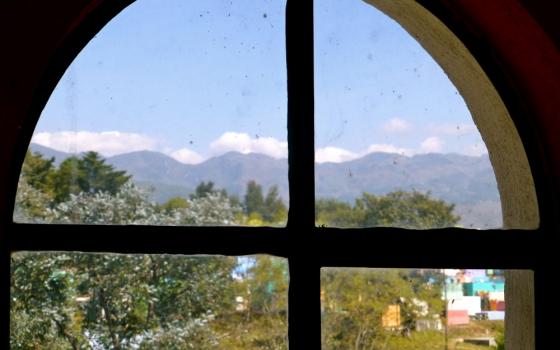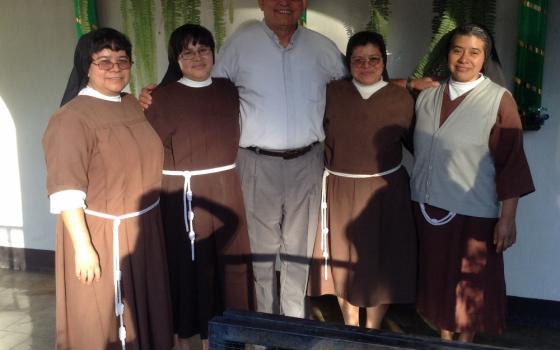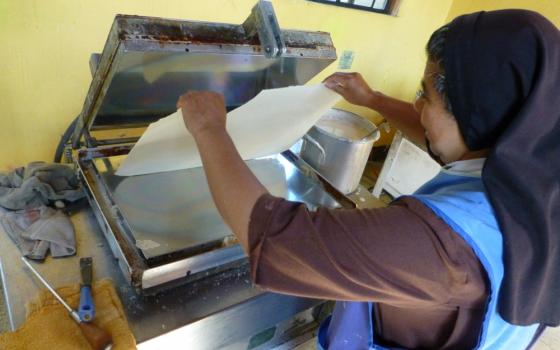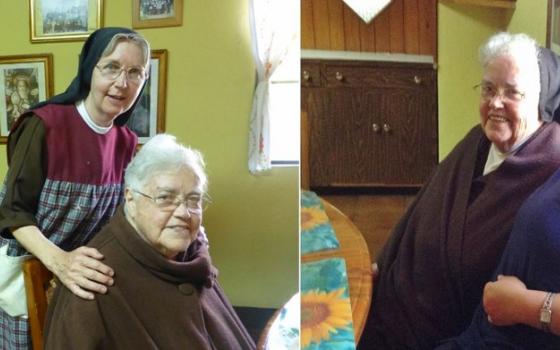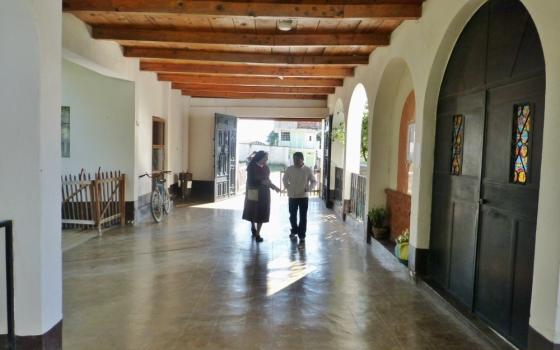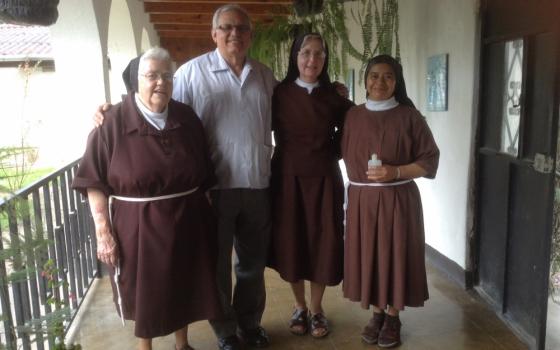An unholy reaction crossed the mind of Sr. Mary Peter Rowland on a day 33 years ago when she first hit the streets of Guatemala, which was supposed to be her new home. Goats and cows still grazed on lots in the capital, Guatemala City, and the unmistakable smell of animal manure wafted through the air.
“Oh, my God, I don’t think I can do this,” Rowland recalls thinking. “I’m from Brooklyn.”
Rowland has toughened considerably since those early days. When she traveled from Memphis in 1981, however, where she had been abbess of the Poor Clares’ monastery, to the western province of Huehuetenango, a civil war was at its height, and Rowland was new to the landscape of violence. Catechists and priests who stood with the poor were being killed. Bodies of students and peasant farmers turned up on the roadside, decapitated. Missionaries in remote villages made reports in code, Rowland recalls, such as, “24 baptisms,” to stand for “24 murders.”
In the 36-year war that ended with a peace treaty in 1996, some 200,000 persons died or disappeared, most of them unarmed indigenous Maya like those who lived in Huehuetenango, at the hands of the army. In the midst of the mayhem, the Poor Clares answered a call from the bishop of the hard-hit province, Msgr. Victor Hugo Martínez, who beseeched the contemplative Franciscan order to come out to the hinterland and pray among the suffering. With five other American sisters, Rowland founded the monastery of Our Lady of Wisdom of the Virgin of Guadalupe, and became its first abbess.
“It was a shock to me,” Rowland remembers. She had not thought of leaving Memphis, let alone the United States. “I never thought of a foundation,” she says, wonder still in her voice. A wry smile crosses her face. “Then you leave the monastery at home and this is it.”
About a six-hour drive east on the paved Pan American highway from the Guatemalan capital led to Huehue, as locals call it (pronounced way-way), a town near the Mexican border where streets off the transnational thoroughfare were still made of packed dirt. It was another “Oh, my God” moment, Rowland says. “We took the road to the bishop’s house and I thought, ‘He doesn’t even have pavement.’ Then I found out the whole country was like that.”
An incident occurred almost immediately that allowed Rowland to share the sense of fear in which others lived. Congregation of Notre Dame Sr. Dolores McKinney, who had been in Guatemala longer, invited her along to make a sick call. As the women crossed town on foot on a Sunday afternoon, in full religious habit, a military jeep pulled up and an officer stepped out to confront them. He demanded their passports. They weren’t carrying the documents.
“Get into the jeep,” he ordered.
Rowland froze. She had read about the local military base as a place of torture and killing. She would not be taken to the garrison, she decided. “I am going to run, and then they’ll shoot me,” she thought, and prepared to bolt.
At that moment she heard McKinney coolly addressing the officer. “We can’t do that,” McKinney said. “We’re not allowed to ride with you because you are carrying arms.”
The words stopped Rowland short. “I thought, ‘Where did she get that?’”
The officer ordered them to walk to the bishop’s house, where the Poor Clares were staying until the new monastery could be built, while he rode with another soldier. At the door, Bishop Martínez looked doubly dismayed. Not only were two sisters under the gun, “But the army was killing priests at the time, and he didn’t want the officers to know where he lived,” says Rowland.
Sr. Doris Gerke, who was in her room with Sr. Agnes Stretz, says Martínez came to their door and said, “Stay put – don’t come out.” He told two Maryknoll priests preparing for Mass in another room to hide. Rowland came to the sisters’ door as she went to find her passport and said only one word, “Pray.”
Martínez hurried to the convent across town where McKinney lived to retrieve her passport. She had instructed the prelate it might be found in the getaway bag all the sisters in Huehue had at the time, packed with essentials should they have to leave the country quickly. Meanwhile, the armed men held McKinney and Rowland.
“The guns didn’t scare me,” Rowland says. Then she realized the officer was drunk. “It was he who scared me. The horror was being taken to their base.”
There was reason for concern. In recent years, forensic archaeologists have been disinterring clandestine graves from the war years. As Rowland spoke recently at the monastery, an exhumation was under way at a former military installation in Cotzal, a town in the Quiché province next door. Remains of more than 60 persons, who had been tortured, would be recovered.
On that afternoon in 1982, however, the tide turned for the two sisters when the officer looked at the wall to see framed photos of local clergy, recognizing a priest with whom he had made a cursillo. He seemed to soften. McKinney “kept him talking about himself, asking about his family.” Finally, the soldiers left. “I’m not sure we would have seen them again, Sister Dolores and Sister Peter, if they had been taken to the base,” says Gerke.
But Rowland remained shaken. News came of armed men entering houses and dragging residents away. Martínez smuggled targeted priests out of the country. (Soon La Salle Christian Brother James Miller, 37, of Wisconsin, would be martyred in a rain of bullets as he repaired a wall at the Huehuetenango Indian School.) Rowland couldn’t sleep at night, and trembled by day at the sight of a soldier, or the unexpected rumble of a truck rounding a corner. Finally, she was sent to the United States. She returned, however, weeks later. Ever since, Huehue has been home.
To spend two days with the sisters at the cloister, its gardens filled with the trees they tend themselves – orange, papaya, grapefruit – is to watch a life of prayer (nine times a day communally), quiet talk and work that, surprisingly to an outsider, spans the hours early to late. At first light one morning, Sr. Sandra Morales, 43, and Sr. Elizabeth Menjívar, 42, join a team of pastoral agents and a local priest in vans and cars, heading for a town two hours away to evaluate the year’s community programs for married couples and youth. “The Church in Guatemala is not excessively clerical,” says Bishop Alvaro Ramazzini, noting that thousands of pastoral agents work the 2,860-square-mile diocese, which is short of priests. “Their predecessors were targeted during the war, and they come to the ministry in great numbers. They are a great example for us.” The sisters are an integral part of the pastoral teams.
In a room off the kitchen, Sr. Ana Maria Mateo Juan, 47, moves between ovens and machinery that will produce 30,000 communion hosts by 10:30 in the morning. Sisters also contribute to their own support by making vestments and rosaries. They work on embroideries, even fashion Christmas cards for yearly sale. They help the poor who come to the door, and since founding the monastery, have administered a small educational fund so needy parents can send children to local public schools – the Catholic school is too expensive.
Of the American Poor Clares who founded the Huehue monastery, with others coming and going over the years, some became sick, some were called elsewhere, others could not manage the language. Of the “originals,” only Rowland, now 80, and Sr. Agnes Stretz, 69, of Pennsylvania remain, joined now by two El Salvadoran women and two Guatemalans. Sr. Ana Maria Mateo Juan, from a Chuj village, is the Poor Clares’ first indigenous Maya sister. A new member recently joined, and the sisters are in the process of interviewing another woman who is interested in joining their community.
“For me we are part of global rounds of prayer,” says Sr. Maria Concepción Menjívar, 48, who succeeded Rowland as abbess five years ago. “As we end praying each time, in other places they are beginning.”
Called in Latin America Madres Clarisas, Poor Clares maintain monasteries in some 70 countries, numbering some 20,000 sisters worldwide, somewhat more than the church’s largest single male religious order, the Jesuits.
“We don’t go into the order to save our souls,” Menjívar says, “but to pray, including for those who don’t have time, or do not themselves pray now. For criminals, rapists, prisoners, the drug traffickers.” Besides the life of continuous prayer, Menjívar was drawn to the Clarisas by the opportunity to “feel part of a community and identify with the rules of St. Clare, made by a woman for women.”
Ramazzini, who came to Huehue only two years ago from the neighboring province of San Marcos where he presided as bishop for 24 years, says in admiration of the sisters, “I trust in their unique charism.” And, with a grin, he adds, “I don’t know how they do it but they know everything that goes on in the diocese.”
The bishop is considered one of the few prominent voices in the church or any other sector who speaks clearly on behalf of the Guatemalan poor.
“God sent his son to give you a life of plenitude and a life of plenitude means that you must have enough food, work, housing, clothes and medical service,” he told a congregation in a recent homily. “Once you have that, you can work for the salvation of your soul.”
For Rowland, Ramazzini is a “true man of God” who merits every support.
The Cuchumatanes Mountains, the highest in Central America, rise outside the monastery’s windows, everlastingly green, a landscape Rowland “loved at first sight.” In the midst of beauty, however, the violence has not disappeared. Instead, she says, after the war ended “other cruelties” arose. Narcotics traffic supplying the U.S. market was pushed out of Mexico into Guatemala, and this border city is particularly affected. Murders. Extortion. Gangs. Beheadings. Recently a gunfight between narcotics traffickers left behind widows and orphaned children who came to the sisters for prayers. Police are felled, and their families come, too. Migration that began during the war has continued, with families separated indefinitely.
“Everybody’s got somebody in the States,” says Rowland. “Or they ask us to pray for a safe journey for someone about to make the dangerous trip.”
Fortunately, Rowland’s own heritage, rooted in a turbulent Ireland before she was born, prepared her for an understanding of how families can be torn by war and how they might remain loyal to each other despite events. When the Black and Tans once raided her grandparents’ house in Ireland, only the photo of a son in a British army uniform stopped the zealots from charging farther up the stairs in search of his brother, an Irish Republican Army guerrilla who would become Rowland’s father. Growing up in New York, where she was born, the girl asked her father, Peter, who had dug marble and trained other IRA guerrillas in the old country, a question: How was it that her uncle, who had also moved to the United States and remained close to them, might have chosen such a different path at one time?
“That’s just the way things are,” said her father, imparting a lesson in acceptance, and that blood triumphs over rancor.
In the United States, Rowland’s family stayed open to the world, subscribing regularly to three newspapers (one in Gaelic), listening to Walter Winchell and Lowell Thomas at night on the radio. Even today, as a cloistered nun, Rowland remains connected to what goes on in Huehue and farther afield. “We know a lot, we have learned a lot,” she says.
“Our chapel is filled on Sundays, and after Mass people come up and talk to us. It necessitates interacting. People come to ask for prayers.”
Huehuetenango remains in the midst of the maelstrom. In the last two years, protests in indigenous communities, sometimes viciously repressed by authorities, have erupted over multinational hydroelectric development in the area.
“Now big companies come in and people don’t have a voice,” says Rowland.
Hours spent with Rowland, who reads avidly, and enjoys conversation with a visitor, beg the question, “How does someone who is outgoing, even an extrovert, choose the cloistered life?”
“I just felt the call,” she says. “God doesn’t call just one kind of person.”
Nevertheless, she says, gazing at the eucalyptus trees outside and her beloved mountains beyond, “I find it hard now. I’m a people person. Not having anyone close to me in age, for instance, and it’s tough even after all these years not to have other Americans around – except for Agnes – with shared roots.”
In the early years, Rowland painted the landscape on free Friday mornings. In the afternoons she heard the sound of the shuttles of the men at their looms, weaving traditional cloth. She no longer paints, and commercially produced clothing has replaced the old weavings. But she carries the gift the place has given to her.
“Here I learned how deep was the faith of the people,” she says. “Men and women both fill the churches, and they remained strong and faithful during the war even though they knew they could be killed at any moment. That’s where Christ is, in the poor. I knew he was in everyone and all that, but here I learned what that meant. It’s people that are important, as Pope Francis says.”
Rowland says she sees change in herself, “the difference time here has made. I began going to daily Mass in third grade and I used to go nuts if I couldn’t go, but you can’t always have Mass here. Now I see also how important it is to go out to the poor, to the people.”
There is little question Rowland will stay in Huehue, she says. “After Mass the people come up to us and say, ‘Sisters, you’re never going to leave us, are you?’ This is where I feel best. This is where God wants me to be, come what may.”
[Mary Jo McConahay is a prize-winning author, documentary filmmaker and freelance journalist who has reported widely on social justice issues.]
